Paeonia
Posted by Aaron Barton on May 4th 2021
Paeonia (Peony)
As spring continues to rouse slumbering perennials from their winter dormancy, breathing new signs of life into sleepy garden beds and giving way to exciting shades of green, a crowd favorite spring bloomer is about to pop: the peony (pee-uh-nee). Belonging to the peony family, Paeoniaceae, peonies are native to many parts of the world including western and northern North America. Peonies bloom one of the most stunning and most anticipated displays of color, signaling that spring is here and that summer is not far behind, blooming prolifically from late spring to early summer. In addition to their incredible spring color, many peonies, such as ‘Duchess de Nemours,’ have wonderfully fragrant blooms, with all peony varieties providing lovely deer and rabbit resistant foliage throughout the season long after blooming has finished, along with excellent salt tolerance for the winter months.
In exchange for their spring show, peonies appreciate when gardeners lend them a helping hand in supporting their massive flowers, as these blooms are also quite heavy for the plant to support. Be sure to support your peony plants with peony cages as they emerge in the spring to ensure that they stay nice and upright, and to keep those blooms off the ground and looking their best for as long as possible. Peony cages, much like tomato cages, provide support for the plant and keep them from flopping over once they are in full bloom. Mature plants form shrubby mounds of around three feet tall and wide once mature.
There is also an exciting hybrid peony, called the Itoh (ee-toe) or intersectional peony. These peonies are a cross between common herbaceous peonies and woody tree peonies, providing the shrubby growth habit of typical peonies, as well as exceptionally large blooms with rigid, self-supporting stems that remain upright without any support or staking. Itoh peonies provide excellent shrub-like structure in the garden, maturing to a slightly larger mound of three to four feet tall and wide over many seasons. Intersectional peonies offer a wide range of colors, including the pink blooms of ‘Julia Rose,’ and the radiant yellow blooms of 'Bartzella.'
Tree peonies, Paeonia suffruticosa (pay-OHN-ee-uh suf-roo-tee-KO-sa), unlike other peonies, are decidous subshrubs, maintaining a woody structure throughout the year. These plants bloom massive flowers and reach a mature size of 4-5' tall and 3-4' wide. Tree peonies have similiar care and site preferences to typical peonies, with the exception of planting depth. Because most tree peonies are grafted plants, it is important to ensure that their grafting union is buried below ground to protect it from harsh freezing temperatures. Plant new tree peonies with their graft union at least two inches below the soil to prevent winterkill and to establish healthy roots for the grafted portion (scion) of the plant.
Peonies prefer full sun but will tolerate part sun, thriving in rich, well-draining soil in areas with excellent air circulation to ensure dry, healthy foliage. Avoid overhead watering peonies and position sprinklers away from peonies to keep foliage dry and prevent fungal disease like powdery mildew from developing on the foliage. Be sure to cut peony foliage back each fall after a killing frost and remove the foliage from the garden bed to keep plants healthy and disease-free.
Fertilize peonies two to three times per season beginning in the spring with a bloom-focused fertilizer to keep plants blooming their best. If desired, mature plants may be divided in the early fall, leaving three to five buds (eyes) per section divided. Dividing in the fall will allow roots adequate time to store energy reserves for the following season prior to division, while still allowing time to begin reestablishment before cool winter temps set in. Be sure to plant divisions only an inch or two below the soil to avoid delaying blooms, as is also the case for any newly planted containerized peonies.
Use peonies as accents along walkways or as great centerpieces in your spring gardens for an incredible spring display of color, or mass for a vibrant hedge in foundation plantings and formal designs.
Happy Planting!

